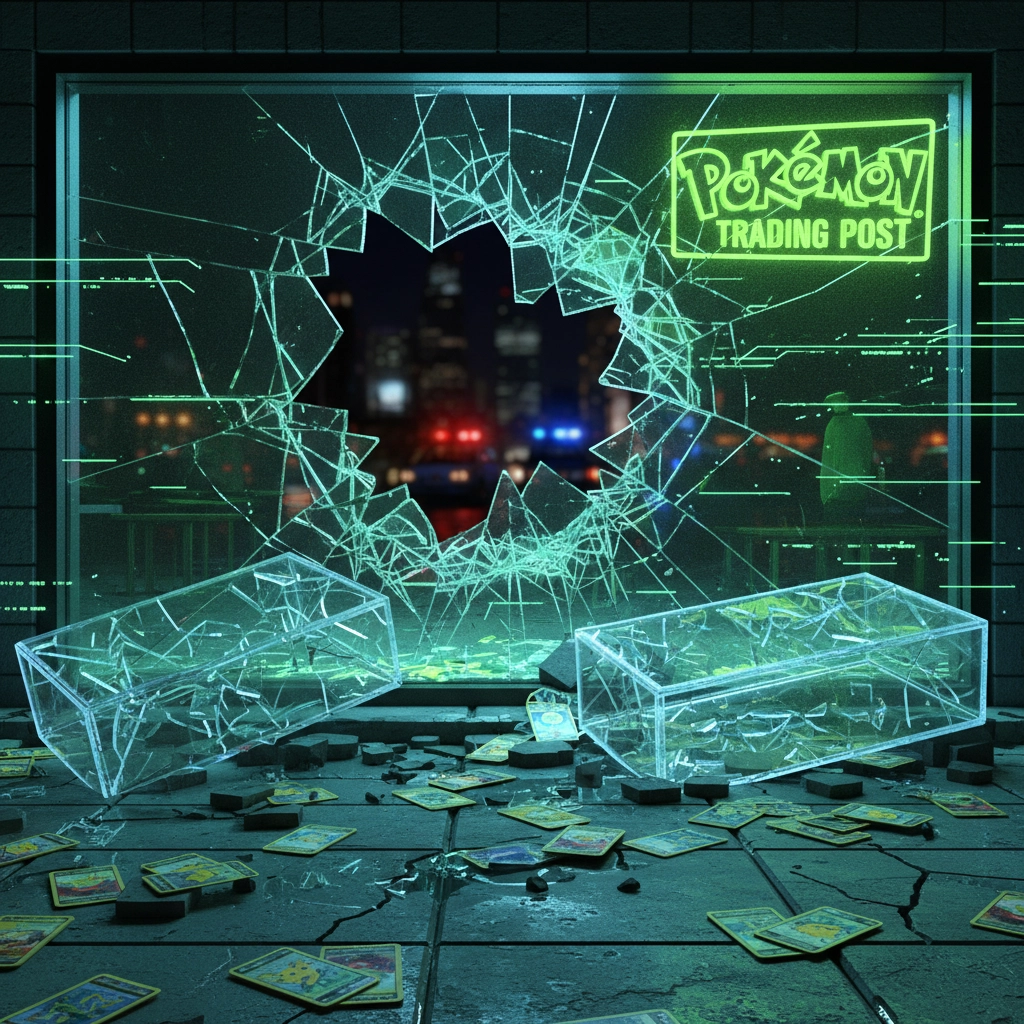Inside the Rash of Card Collectibles Crimes: Recent Heists and the Rising Stakes for Collectors
- Dr. Mardis

- Oct 23
- 4 min read
Three major criminal operations hit the collectibles world in 2025. Each exposed different vulnerabilities. Each cost millions.
The Ontario Smash-and-Grab
October 2025. Guelph, Ontario. Someone broke into a card shop overnight. They took several thousand dollars worth of Pokémon cards. Police called it targeted theft.
The thieves knew what they wanted. They ignored other merchandise. They took only premium cards. This wasn't random.
Similar break-ins occurred across the Triangle area of North Carolina. Raleigh. Garner. Three shops hit in one week. Over $30,000 in Pokémon inventory gone.

Shop owners noticed the pattern. Criminals studied their layouts. They knew which cases held rare cards. They bypassed security in under two minutes.
The Ontario incident followed this template exactly. Quick entry. Selective targeting. Clean exit.
The $350 Million Forgery Empire
Summer 2025 brought bigger news. Brett Lemieux ran Mister Mancave. His company sold over four million forged items. The fraud totaled $350 million.
Lemieux sold through auction houses. He sold through private sales. He did this for years. Nobody caught him.
The operation was sophisticated. Forged memorabilia looked authentic. Some items were trading cards. Most buyers never suspected.
Authorities raided his operation. Lemieux died by suicide soon after. His death was ruled intentional.
This case dwarfed previous fraud in the industry. $350 million exceeded all known collectibles fraud combined. The scale was unprecedented.

The Systematic Pattern
These weren't isolated incidents. Criminal organizations now target collectibles systematically. They research. They plan. They execute.
Florida saw coordinated hits in August. One theft netted $30,000 in Pokémon cards. The thief wore identical clothing to other regional break-ins. Same hoodie. Same gloves. Same tote bag.
Michigan reported similar activity. Clinton Township lost nearly $5,000 in cards. Maryland shops faced repeated break-ins. Eldersburg. Bel Air. Ellicott City. Reisterstown.
The pattern is consistent across regions. Quick entry through front doors. Direct targeting of high-value cases. Exit within 75 seconds.
Why Now
Card values exploded. Pokémon cards that sold for $3 in the 1990s now sell for over $1,000. Some graded specimens reach five figures.
The global Pokémon market grossed $1.9 billion from 2023 to 2024. Individual cards became trackable assets through grading companies like PSA and BGS.
Criminals adapted. They study price guides. They identify the most valuable items. They can convert stolen cards to cash quickly through online marketplaces.

Baseball cards faced similar targeting. The Dallas Card Show heist in July netted over $2 million in vintage cards. This represented one of North America's largest card show thefts.
The Authentication Problem
Grading companies create both security and vulnerability. Serial numbers make cards trackable. But the same system enables sophisticated fraud.
Brett Lemieux's operation showed how deep the authentication problem runs. Forged items passed through major auction houses. Buyers paid millions for fake memorabilia.
Grading companies can deactivate serial numbers on stolen cards. But this happens after theft. Prevention remains limited.
The authentication infrastructure wasn't designed for current crime levels. It assumes good faith from dealers and auction houses. Recent cases prove this assumption wrong.
Impact on Collectors
Shop owners now face inevitable targeting. Sean Viera of 1st Edition Collectibles stated: "It wasn't a matter of if, it was a matter of when."
Insurance doesn't cover full losses. Specialty collectibles policies cost more than most shops can afford. Recovery rates for stolen cards remain under 20%.
Community trust eroded after the Lemieux scandal. Collectors question authentication. They doubt auction house verification. They avoid high-value purchases.

Some collectors moved valuable items to bank safety deposit boxes. Others installed private security systems. Many simply stopped buying premium cards.
The market adapted through fear. Not innovation.
Law Enforcement Response
Police departments lack specialized collectibles crime units. Most officers don't understand card values or authentication systems.
The New Bedford theft was solved through a tip. Someone recognized a stolen card being sold online. This was luck. Not systematic enforcement.
Cross-jurisdictional coordination remains poor. Florida thieves operated across multiple counties. Each jurisdiction investigated independently. Patterns went unrecognized for months.
Federal involvement occurs only when fraud exceeds certain thresholds. The Lemieux case qualified. Most shop break-ins don't.
Current State
October 2025. The crime wave continues. Shop owners upgrade security. Criminals adapt their methods.
No comprehensive solution exists. Authentication remains vulnerable to sophisticated fraud. Physical security stops only amateur thieves.

The collectibles industry generated billions in sales. It invested little in crime prevention. Current security measures were designed for different threat levels.
Market growth outpaced security infrastructure. Criminal organizations noticed. They responded accordingly.
What's Next
More incidents will occur. The profit potential is too high. Security measures remain too weak.
Some shops will close permanently. Others will relocate to more secure facilities. Many will reduce high-value inventory.
Collectors will adapt through avoidance. They'll buy lower-value items. They'll trade privately. They'll avoid public shows.
The market will contract. Not from lack of demand. From lack of security.
Criminal organizations will expand operations. Success breeds imitation. Other high-value portable collectibles will become targets.
Sports memorabilia. Comic books. Vintage toys. All face similar vulnerabilities.
The pattern is established. The response is predictable. The outcome is inevitable.
More crimes. Higher values. Better organized criminals.
This is the current state of collectibles security. This is what collectors face now.
Comments